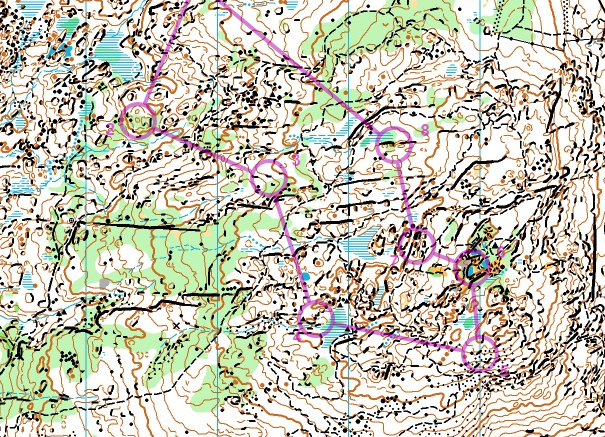Middle - Robbie
The weekend kicked off with the middle distance at Storr’s Pond. Since the first starts weren’t until the afternoon, Jan Erik, Tomas, and I went out on the model map to get a feel for the terrain.
When I arrived at the start there was quite a lot of commotion. It seemed that everybody had forgotten something whether it was an SI, compass, or start time. Along with forgetting my own SI and having to borrow an ancient model 5, I also realized that I had forgotten something far more important… How to orienteer! My original race plan “medium speed, no mistakes” quickly turned into “full speed, full mistake”.
 |
| The technical loop of the M20 course. The forest was very nice and open and combined with all the trails around it was easy to open up the throttle in most sections. |
I was lucky enough to get through the course with only bobbles and hesitations rather than any big blow-ups. After chatting with others after the race it seemed that a lot of us had gotten a little too excited for the race and made several mistakes in the woods. But that didn’t stop people from pushing hard right to finish line.
 |
| An epic battle between Jan Erik Naess and Graeme
Rennie in the finish chute (Graeme won). |
The first places in the elite category went to Emily Kemp and the one and only Thierry Gueorgiou who was closing his North American tour with NAOCs. It was exciting to see le Roi de la Course d’Orientation in action.
 |
| Some random French people. |
Long - Pia
Next up was the long distance, not only grueling in terms of length, but also in terms of the map. As noted in the event handbook, the flat and boring looking walk was deceptively calm and a complete contrast compared to the terrain.
 |
| This map at 1:15 000 was one of the hardest maps I have ever read. |
For the first couple controls every time I wanted to read the map I had to stop dead just to focus on the tiny rocky details. Around the 6th control I finally got into the flow of things, only to mistake a trail on the map for a series of cliffs, and the whole thing fell apart until I decided to just head north until I hit something I recognised.
 |
| The long leg from the W20 course. |
The last couple controls went by fast, and before I knew it I was running through the spectator loops, finishing the last couple controls and running down the really really short finish chute (4 second best time split!).
 |
| Adam rounding the corner in the finish chute. |
After that, all that was left was to relax and watch the juniors boys finish and the exciting race in the seniors as they competed for the individual spot for WOC next year.
Sprint - Pia
Finally, it was the day of the sprints. First off was the individual race on Dartmouth campus, a typical college campus with plenty of randomly shaped buildings and relatively flat lawns separating them. There were some trickier sections with underpasses as well, but, on the whole, it was a runners’ course, and I was not 100% feeling it in the legs.
 |
| How would you go from 1-2 (don’t forget about the underpasses)? |
There was another exciting competition in the elite classes, with two of our very own juniors competing among the elites - and holding their own! The final positions ended with Canadian victories for both the men and women, with Emily Kemp taking 3 for 3 in the individual classes and Damian Konotopetz and Will Critchley both running faster than Thierry! Jan Erik finished in a strong 7th place and Emma W in 6th. In fact, she was in first place until the 9th control!
 |
Emma W, Emily, and Tori
Photo taken by of David Yee
|
Ignoring the stares from all the college students wandering across The Green, we relaxed and recovered in preparation for the sprint relay.
Sprint Relay - Robbie
After the individual sprint, Hans Fransson eastern Canadian coach rounded up all the Canadian athletes and put together five teams. Four senior and one junior. We were all whisked away to the basement of a nearby building which would serve as our quarantine. We prepped for the race by coating ourselves with some tattoo team spirit courtesy of Emma Waddington.
 |
Ready to race!
|
The race itself was very similar to the individual sprint through a similar area of campus. Not very technical but very very fast as a result.
|
|
| The format of a sprint relay is 1st and 4th legs women, 2nd and 3rd legs men. Here is the mass start. Go ladies go! |
The race was very tense with the lead being passed around between teams.But in the end, Emily Kemp brought her team composed of Damian Konotopetz, Will Critchley, and Louise Oram to victory.
 |
Thanks to some great racing by everyone over the weekend, the Canadian senior team won the Bjorn Kellstrom Cup!
|
Full results and maps can be found at http://www.naoc2016.us/results
























